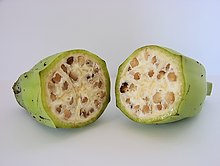
Back نمط بري Arabic Divlji tip BS Tipus salvatge Catalan Divoký typ Czech Wildtyp German Άγριος τύπος Greek Wild type Spanish Ulukalleel Estonian گونه وحشی Persian Type naturel French

The wild type (WT) is the phenotype of the typical form of a species as it occurs in nature. Originally, the wild type was conceptualized as a product of the standard[1] "normal" allele at a locus, in contrast to that produced by a non-standard, "mutant" allele. "Mutant" alleles can vary to a great extent, and even become the wild type if a genetic shift occurs within the population. Continued advancements in genetic mapping technologies have created a better understanding of how mutations occur and interact with other genes to alter phenotype.[2] It is now appreciated that most or all gene loci exist in a variety of allelic forms, which vary in frequency throughout the geographic range of a species, and that a uniform wild type does not exist. In general, however, the most prevalent allele – i.e., the one with the highest gene frequency – is the one deemed wild type.[3]
The concept of wild type is useful in some experimental organisms such as fruit flies Drosophila melanogaster, in which the standard phenotypes for features such as eye color or wing shape are known to be altered by particular mutations that produce distinctive phenotypes, such as "white eyes" or "vestigial wings". Wild-type alleles are indicated with a "+" superscript, for example w+ and vg+ for red eyes and full-size wings, respectively. Manipulation of the genes behind these traits led to the current understanding of how organisms form and how traits mutate within a population. Research involving the manipulation of wild-type alleles has application in many fields, including fighting disease and commercial food production.
- ^ "Wild Type vs. Mutant Traits". Miami College of Arts and Sciences. Retrieved March 2, 2016.
- ^ Chari, Sudarshan; Dworkin, Ian (2013). "The Conditional Nature of Genetic Interactions: The Consequences of Wild-Type Backgrounds on Mutational Interactions in a Genome-Wide Modifier Screen". PLOS Genetics. 9 (8): e1003661. doi:10.1371/journal.pgen.1003661. PMC 3731224. PMID 23935530.
- ^ Jones, Elizabeth; Hartl, Daniel L. (1998). Genetics: principles and analysis. Boston: Jones and Bartlett Publishers. ISBN 978-0-7637-0489-6.